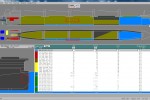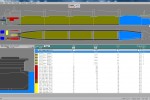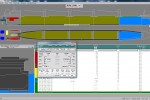ANKOMarine Load Planner
- Standard Configuration
- Additional Modules
- Damage & Safety
Functions and Features
- Interactive graphical profile and plan views of the vessel and compartments
- Display of the actual loading condition and calculated results on the vessel plans
- ASTM/IP built in tables allow automatic correction of Crude oil and Products' density with temperature
- Additional tables can optionally be added
- Cargo densities, definition and conversion
- Tanks Loading by Sound, Ullage, Weight, Volume or Percentage
- Stores and Consumables
- Full validation of user inputs
- Free Surface Moments
- Constants modification. Dual set of constants (actual and constants as in the loading manual)
- Tank cubic capacity
- Tank top strength
- Loading Summary, block unloading of a selected load
- Stability Analysis
- 2D or 3D hull model, depending on the loading manual method
- GZ-Theta graphical stability curve
- IMO Criteria
- Damage Stability, check actual GM/KG against predefined limiting curves
- Error messages, warning and safety critical (Stability, Strength, Free-board)
- Longitudinal Strength, graphical and interactive read-out at any frame
- Harbour and Sea going limits
- Multiple strength limits as assigned by Class or alternative limits for hogging and sagging
- Ship weight distribution report, to check dry-docking position of supports
- Drafts at the perpendiculars and at the draft marks
- Draft zones selection and adjustment
- Sea-water density effect on the loading condition of the vessel
- Trim check
- Propeller Immersion
- Storage and retrieval of unlimited number of loading conditions
- Metric, British or mixed system of units and automatic units conversion
- Print outs or complete reports. Text and graphical output
- Import/export of loading conditions. Export conditions by e-mail
- On-line help
Chemicals Loading and Chemical Cargoes database
Generates cargo compatibility charts for the cargoes to be loaded. This is a comprehensive chemicals database, which contains information on all cargoes referred to in the certificate of fitness.
Additionally it:
- Accommodates cargoes for the loading of which a certificate of fitness is not required and it is user expandable
- Allows simultaneous loading of chemical and non-chemical cargoes
- Checks all compatibility (cargo to cargo, cargo to tank/coating, tank position) restrictions during loading
- Handles cargo to previous cargo restrictions by using the historical database
This module provides a wide range of decision support features during loading and accounts for automatic heel adjustment.
Auto Trim
Modification of the contents of one compartment or transfer of load between compartments, to achieve the required trim.
SF Correction
Correction of the calculated shearing forces due to loading on alternative holds, according to the pertaining Class rules.
Vessel Particulars
Displays useful information of the vessel, such as tank, deck, machinery details, consumption and so on.
- On-Line Interface to Tank Level Gauging System
- Historical Database
- Tank Technical Database
- Tank Cleaning Procedures Database
- Ullage Report - Excel Report
- AutoPlan - Automatic Load Planning & Optimization
- Graphical Stowage Plan Summary
- Pre-Planning - Loading Simulator
- ASTM/IP Conversion Tables
- Bunkering
- Loading by Non-Corrected Ullage/Sounding
- Draught Survey
- Air Drafts
- Visibility Check
- Deadweight Scale - Parallel Middle Body
- Sloshing Calculations
- Gain/Loss of Cargo due to Sagging/Hogging
- Vessel Particulars and Plans
- PDF Export
On-Line Interface to Tank Level Gauging System
This module of ANKO provides the necessary components for interfacing to all known Tank Level Gauging Systems.
To this effect, the communication protocol provided by the tank level gauging system manufacturer for the specific vessel, is implemented.
The on-line readings automatically update the tanks' loading status (Ullage/sound, volume, Temperature), the vessel's floating position, strength and stability are calculated and when required, parameters are transmitted back to the gauging system.
The whole process is interactive. The user, at any time, has an overview of tanks' flow rates, time to reach high or load level settings as well as the vessel's status.
If a strain gauging system is installed, ANKO will read the measured stresses and display them against the calculated ones.
Bar Chart View
In the on-line mode an alternative window is provided that displays the tanks' contents and other useful information in a graphical bar chart view. High and low level alarms are user defined and clearly displayed on the bar chart view together with the actual tanks content level. Audible and visible alarms are built in with the option to mute as required.
Historical Database
Voyage History database
Provides information for tracing and evaluating vessel utilization within a period. It contains information on previous voyages such as departure/arrival, from/to ports, dates, cargoes carried as well as the actual vessel's loading.
Loading History database
Contains all previous vessel loadings with information on a per tank and cargo basis. Allows queries, related to cargoes carried by the vessel or cargoes loaded in a given tank and in a time period.
Tank Cleaning History database
Stores the cleaning procedures followed, and allows a range of queries regarding the cleaning history of tanks, including notes on the procedures followed.
Tank Condition History database
Defines and stores the “Tank Condition Report”. Provides a graphical representation of the tank bottom/sides, where the user can interactively mark the location, extent and degree of tank coating deterioration. Possibility to store and retrieve, apart from the of “Tank Condition Reports”, the corrective/maintenance activities carried out in a tank, between reports. Full validation to warn the user and prevent erroneous entries.
Tank Technical Database
This database contains specific technical information about the devices and the systems that each tank is equipped with. Such information includes:
- Cargo Information such as min/max cargo temperature, cargo lines, drop lines
- Monitoring Devices such as pressure monitor device, tank coating, temperature
- Specific Information such as tank vent, tank capacity, tank surface area
- Heat Cooling Systems such as heating coil, cooler, diffuser
Tank Cleaning Procedures Database
This database contains the company’s specific cleaning practices and techniques. A cleaning procedure consists of a number of cleaning steps. Both cleaning procedures and steps can be modified/enhanced/expanded by the user to reflect the company's specific practices.
Ullage Report - Excel Report
This module allows interactive input of ullages (e.g. Hole, UTI, Portable or Float gauge), water dip and temperature and:
- Corrects ullages for Trim, Heel and Temperature
- Calculates the Total Observed, Gross Observed and Gross Standard Volumes per tank and in total
- Applies the wedge formula in the calculations, when needed
- Produces complete Ullage Report, including all corrections
Ullage report to EXCEL©
Prints a detailed Ullage Report to an Excel© spreadsheet. The user can add, edit and print information such as Experience Factor, OBQs, Port/Terminal and Master/Chief Officer/Surveyor names.
AutoPlan - Automatic Load Planning & Optimization
AutoPlan automatically loads and distributes cargo, consumables and ballast so that:
- Required quantities of one or more cargoes and/or maximum quantity of one grade are loaded
- Minimal stresses are exerted on the ship structure
- Operational constraints such as draft/trim and strength levels are met
Multi-port, step by step planning is supported. AutoPlan is a unique decision support tool for ship operation and chartering.
Graphical Stowage Plan Summary
Single page presentation form of loading summary typically used to provide stowage overview to charterer.
The form displays a colour graphical Tanks Arrangement. The information on each tank includes the grade carried, its density, quantity and POL, POD. Summary by grade and other on board weights are also included in the form. The form can be printed, customized with the company logo.
Pre-Planning - Loading Simulator
This module is designed to facilitate load Pre-Planning through an interactive simulation of the loading/unloading process. The process is time based, takes into account the load and discharge rates and monitors the various strength and hydrostatic parameters throughout.
Detailed graphs for the variation of strength and stability parameters such as trim, drafts, GM, SF, BM over the duration of the load/discharge operations are provided.
ASTM/IP Conversion Tables
This is an independent utility, which allows the conversion between a wide variety of cargo density units for Crudes and Products. In addition, it calculates the density variation for different temperatures taking into account the hydrometer correction. During loading, the above process is done automatically in the background. The following ASTM Tables are included: 5A, 5B, 6A, 6B, 6C, 23A, 23B, 24A, 24B, 24C, 53A, 53B, 54A, 54B, 54C.
Bunkering
Provides complete pre-bunkering, post-bunkering and comparative summary calculations and reports. Trim, heel and temperature corrections are applied. Averaging of densities and sulphur content per tank are accounted for.
The user inputs initial and final ullages or soundings of FO, DO, LO tanks at a specified trim and heel, at which measurements have been taken. The system corrects the input ullages for Trim and Heel, as well as for temperature variation. The calculated corrected ullages can optionally update the active loading condition of the vessel.
Both Initial and Final bunker surveys are available.
The bunkering module takes into account:
- Density variation due to mix of different densities in tanks
- User-defined High/Low limit for sulphur content percent
- High & Low sulphur, percent sulphur content adjustment, due to mix of fuels in tanks
- Consumed fuel or diesel during bunkering and other useful information
Bunkering report is produced in EXCEL© format.
Loading by Non-Corrected Ullage/Sounding
This is used to load FO, DO, LO and WB tanks based on the non corrected ullage or sounding measurements.
The system corrects input for Trim and Heel, as well as for temperature variation and the calculated quantities directly update the actual loading condition.
Draught Survey
Based on the readings at the draft marks, it calculates the loaded cargo or the vessel constants. Corrections are made for Trim, Hogging/Sagging and Sea Water Density.
Provides two modes of operation:
- Before Loading: Calculates actual constants and OBQs and their LCG
- After Loading: Calculates the cargo loaded
A combined Initial and Final draft survey version is also available to enable comparative display and printing of Before and After Loading draft survey results.
Air Drafts
Air drafts are calculated and displayed on any number of predefined longitudinal positions.
Air drafts are are also calculated at the side of the hatches.
Visibility Check
This module performs a visibility check, as per the SOLAS Reg. 22a.
The 2D version calculates and graphically displays the invisible length.
The 3D version carries out detailed geometrical calculations and graphically displays both the invisible length and the blind and clear visibility sectors.
Calculations take into account the actual shape of any obstacle, such as loading gear, container or other deck cargo. Furthermore, calculations are made for the loading condition that is the actual trim, heel and draft of the vessel Additionally, it checks invisible lengths for Panama and Suez canal navigation.
The view point can be on the center-line, or be moved transversely. In addition, trim heel and draft can be modified interactively so that the visibility for alternative loading conditions may be examined.
In ballast exchange operations, the visibility is checked in the background and a warning is displayed, if needed.
Deadweight Scale - Parallel Middle Body
Given the:
- Sea water density
- Trim
- DWT, Displacement or mid draft
This module calculates and displays drafts at PP and marks, DWT and displacement, as well as a number of important hydrostatic parameters.
In addition, the parallel middle body (PMB) and the distance of aft/fore ends of the PMB from amidships are also calculated and displayed.
Sloshing Calculations
For the actual loading condition, every tank is checked against resonance between ship and liquid motions in tanks, both pitching and rolling, as per pertaining classification rules.
Gain/Loss of Cargo due to Sagging/Hogging
This calculates the deflection, that is, Hogging/Sagging of the vessel and estimates the respective gain/loss of cargo.
Vessel Particulars and Plans
Displays vessel particulars. Furthermore, enables addition of any number of ship-related files by the client, including ship's drawings. The added files are automatically identified by the software and added in the list of items that the end-user can select for display.
The General Arrangement, Capacity Plan and Mid-ship Section, are included as a standard in the initial software delivery.
Additional drawings can also be included, subject to agreement.
PDF Export
This facility provides a custom PDF printing driver, and allows saving any print out to a PDF file, a format suitable for electronic transmission.
Appending pages to an existing PDF file is supported. This option is useful in case there are no other PDF drivers installed.
- SAFESALV - Emergency Response
- Statutory Damage Check
- Intermediate Stages of Flooding
- Damage Simulation
SAFESALV - Emergency Response
SAFESALV is an advanced system for the immediate assessment of Damage/Grounding vessel conditions and the evaluation of alternative salvage scenarios. SAFESALV provides all those facilities which allow the on-line interactive examination of What If scenarios, making it a powerful decision support tool.
The SAFESALV system is used for Emergency Response.
In SAFESALV the user defines the initial loading condition and indicates the damage on the vessel, working on the actual vessel plan. In case of grounding or combined damage and grounding, the measured draughts at selected points around the vessel, as well as the type, and optionally the extent, of grounding, are input.
As soon as the damage is specified, the floating position in the damaged condition is found. The IMO damage stability criteria are checked and the stresses exerted on the ship’s structure are calculated. User inputs and calculated results are graphically displayed.
Flooding
The cargo permeability can be set by the user. For partially filled holds with bulk cargo, calculation of the combined permeability is carried out. In particular, the system considers the loaded and free space of each hold with different permeabilities. Depending on the calculated in-flooded water level, the combined permeability is found and accounted for.
The damage calculation is based on either liquid surfaces parallel to the waterline or, optionally, on frozen surfaces. Damage conditions can be stored and complete reporting is available.
Marginal points are displayed graphically. In the print out the calculated actual Free-board and Immersion angle at each marginal point are shown.
Cargo Shift
Given the heel of the vessel, the shifted cargo TCG is adjusted so that the calculated heel matches the observed.
Grounding Calculations
Grounding and re-floating calculations include:
- Grounding area
- Grounding force and position
- Force required to free the vessel
- Pressure on grounded area
Different types of grounding, that is, on One Pin, Two Pins or Seabed can be examined. Tide can also be defined and taken into account.
Off-line interactive evaluation of corrective actions/scenarios can be carried out.
Simultaneous flooding and grounding is supported by SAFESALV.
Residual Strength
Provides an estimation of the effect of the structural damages on vessel's strength. The position and extent (in terms of length, breadth and depth) of the structural damages are given by the user. The residual strength is estimated by re-definition of the permissible bending and shear stresses after the structural damages.
Note: SAFESALV is also available as a Stand-Alone Tool.
Statutory Damage Check
Performs Damage Stability Calculations on the current loading condition, as per MARPOL, Annex I, Reg.28 requirements.
The vessel is checked by default for a number of built in damage cases as specified for the vessel at hand by MARPOL. A complete summary report is produced at the end of calculation for the examined damage cases.
If not restricted by Class additional damage cases can be interactively defined.
Intermediate Stages of Flooding
The final condition of equilibrium after damage is not always the most critical. It is therefore necessary to check and verify that the stability of the vessel is adequate during the Intermediate Stages of flooding - MARPOL Reg. 28.
This module calculates and displays the vessel's status that is strength, floating position and stability criteria for a range of Intermediate Stages of Flooding. The added weight method is applied in the calculations, whereas the final condition of equilibrium after damage is evaluated by the lost buoyancy method.
The amount of water per stage is based on applicable class directives. The Lloyds Register methodology for evaluating the added water per stage is applied by default.
Damage Simulation
This is an enhancement to the SAFESALV Damage Stability/Emergency Response module. The objective is to simulate in a quasi static manner the vessel's status starting from the intact condition and follow through to the final position of equilibrium after damage.
The system by taking into account the actual position of damage openings wrt the sea level, it will:
- Flood progressively all damaged compartments
- Calculate and display in a tabular and graphical form the vessels status at any stage of flooding
- Estimate the outflow, taking into account the internal gas pressure and the effect of swell


